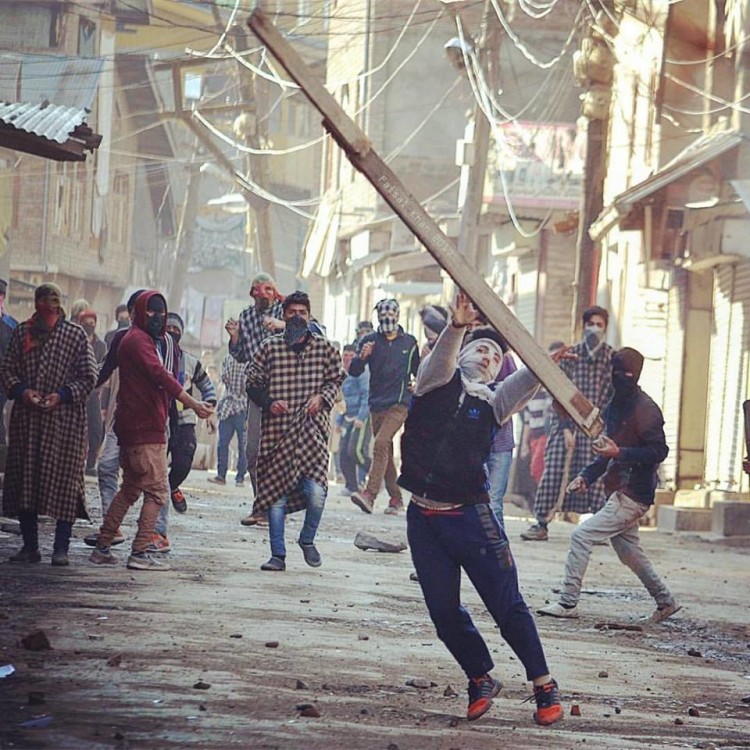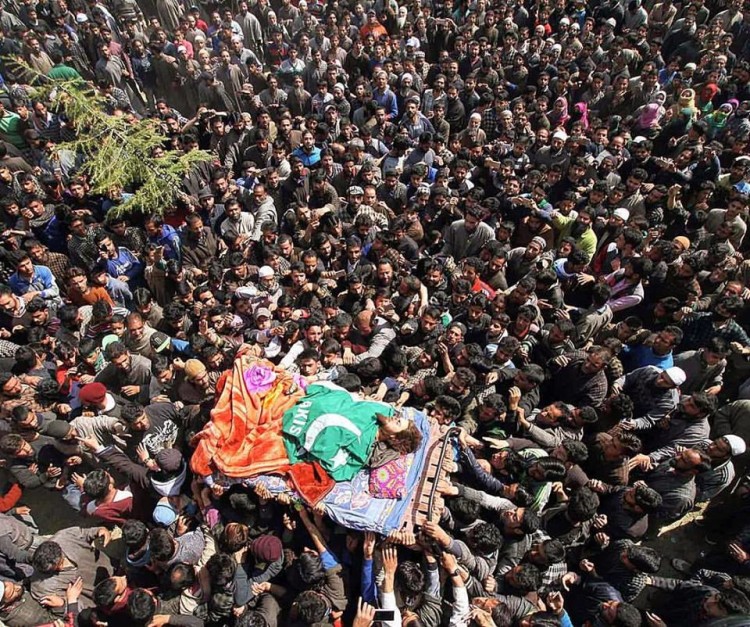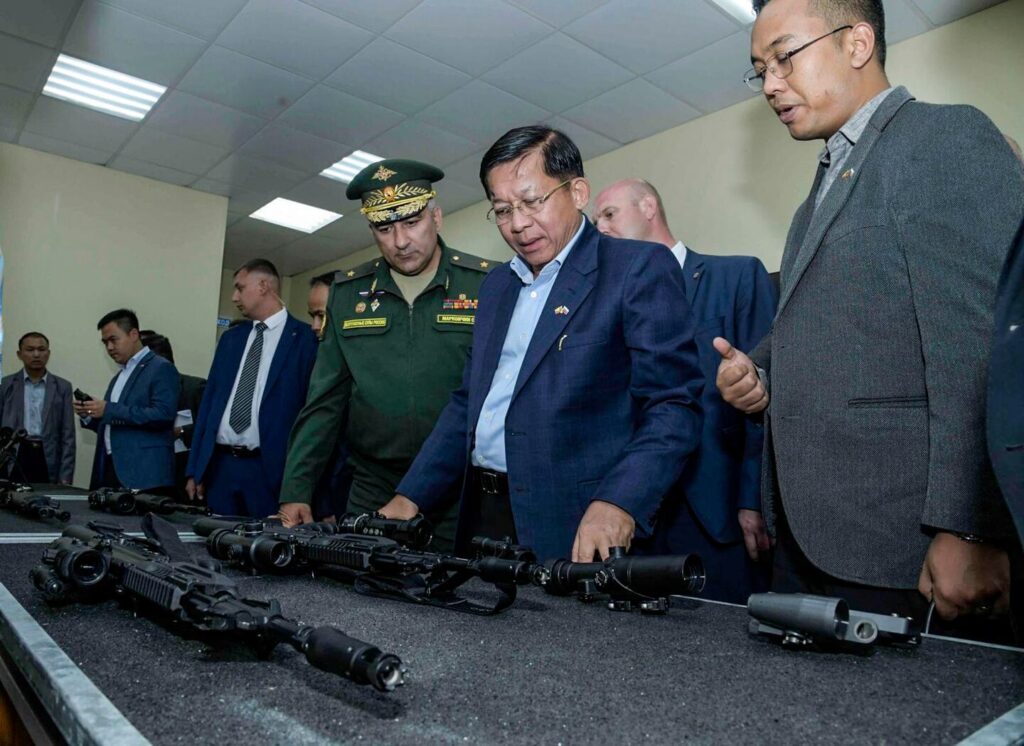MANTRAYA ANALYSIS#13: 24 APRIL 2017
MADHUMITA DAS
Abstract
There has always been a gulf between Kashmiri aspirations, the compulsions of India, and to a lesser extent, Pakistan. The ongoing revisionism in India’s body politic, led from the highest echelons of State power, however, does not seek to bridge this gulf, but rather exacerbate it. Isolating and defeating Kashmiri, as dissident Muslims, while hardening its territorial claim is an essential element of the new nation-building project. It is line with the majoritarian agenda afoot in the Indian mainland itself. Given the nature of the Kashmiri Gordian knot, the strategic advantage is reaped by Pakistan.

(Scene of a street protest in Srinagar in February 2017)
“I say, let them conduct another re-poll. They might then understand the Triple Talaq!”
This Facebook update was one of the hundreds circulating in Kashmiri circles on 13 April 2017, when the re-polling for the Jammu & Kashmir Assembly elections for the Srinagar-Budgam constituency returned a mere two percent participation, down even from a meagre 7.13 percent on 9 April. 20 of the 38 polling stations in the re-poll saw no participation whatsoever.[i] Thus then, the ‘summer of unrest’[ii] in Kashmir, snowballing with the death of Hizb-ul-Mujahideen commander Burhan Wani on 8 July 2016, has come full circle. And it shows no indication of abating. There is much that is iterated in the developments of past year. However, several novel dynamics have come into play as well. First, the following iterations.
The Kashmiri Gordian Knot and the Absence of Kashmir
For the Kashmiri, the demand for the right to complete self-determination (‘Hum Kya Chahte?’ loosely translating into ‘what do we aspire for’), notwithstanding several constituencies who advocate autonomy within either Pakistan or India, has been a constant fixture, in intent, if not intensity, for at least close to three decades now.[iii]However, since Kashmiri subjectivity does not feature in the agenda of both India and Pakistan, except tangentially, in order to bolster their own stakes, the Kashmiri perspective, the elephant in the room, will be shelved for the meanwhile, and retrieved later.
For India, most explicitly since 1994, the territory of the princely kingdom of Kashmir, is an integral part, while the territory under its control- Jammu and Kashmir (hereafter J&K), is an internal matter.[iv] Pakistan’s Kashmir agenda has always been revisionist-historic, and the fulcrum of its national identity, both externally and internally. It is the touchstone upon which the Army justifies its role as the State personified; Kashmir is also what helps political parties win elections.[v]
The portion of the militancy in the Kashmir valley, in J&K that is abetted by Pakistan is part of its strategy of asymmetric and sub-conventional warfare, bolstered only by a nuclear second-strike stalemate.[vi] India’s stock response has been to equate such militancy with terrorism (riding the global wave of the now disreputable ‘War on Terror’), to shame Pakistan on international platforms, and a refusal to engage bilaterally with it, on all matters, and most certainly on Kashmir- on the plank of the sponsorship and abetment of terror. On ground, India’s prerogative has been to cement the Line of Control (LoC), and contain cross-LoC infiltration.
The closest meeting point between India and Pakistan was reached in the now almost mythic ‘four-Point Formula’[vii] negotiated between General Pervez Musharraf and Prime Minister Dr. Manmohan Singh, that advocated first making the LoC an international border, (negating the stances maintained by both States), and then making the resultant border ‘irrelevant’ to the Kashmiri.
Merely a decade later, both India and Pakistan are back to feeding off the other’s alleged lack of a locus standi on Kashmir. For India, everything that goes ‘right’- electoral numbers, lower levels of infiltration and active militancy in the valley, tourism, is the success of India’s nation-building (counter-insurgency to be precise) project; everything that goes ‘wrong’- ‘unrest’, ‘stone-pelting’, ‘separatist elements’ consolidating the ‘local population’, the rise of the ‘home-grown militant’ and even the occasional waving of the flag of the Islamic State is Pakistan’s doing. Except that, by such standards, the ‘situation’ in Kashmir is now advantage Pakistan, the fall-outs of which Pakistan does not hesitate to usurp and use.[viii]
Implicating Pakistan, ironically, further reduces the space for India to acknowledge and engage with Kashmir, and ends up reducing India’s legitimacy in the valley, dramatically, and drastically, day upon day. Thus far, different regimes in New Delhi had brought with them differences in the degree of (non)engagement with Kashmir, while their substance remained almost the same.
A Revisionist India and the Re-envisioning of Kashmir

(People carry the dead body of HM cadre Shahbaz Ahmad Wani alias Rayees Kachru
during his funeral ceremony in Pulwama on 27 March 2017. Photo Courtesy: Faisal Khan)
With the increasing evidence of a revisionist idea of India underfoot the current regime, encouraging of and propelled by a muscular majoritarian communalism, India’s relationship with Kashmir too seems to change.[ix]The United Progressive Alliance (UPA) Government did go the distance of appointing a three-member panel to engage (not necessarily involve) some voices from among the Kashmiri. Of course, it ended up neither acknowledging the findings of the subsequent report, neither the ubiquitous rejoinder- ‘Azadi’.[x] The National Democratic Alliance (NDA) Government, in its current avatar, has instead committed to transforming, “Kashmir in a year, no matter how the change takes place.”[xi]
It is no surprise that the churning in India’s body politic is taking place at the same time as the intensification of its occupation of Kashmir. Occupation here refers not to the registers that the Kashmiri, or Pakistan, or sections of the international community use to describe India’s role in J&K. It refers to the current phase in India’s long and varied record of counter-insurgency (COIN).
While extra-judicial torture, killings, and disappearances, have been the norm since 1989, firing protestors and stone-pelters to death began in 2008, with 70 Kashmiri’s felled during the Amarnath Land Row protests. In 2010, the death toll scaled up to 120. In the past year, however, the mass protests mourning the militants’ ‘encounters’ and observing the Hurriyat’s Shutdown Calendars, saw not just the widespread and indiscriminate use, but also the escalation of the pellet gun tactic. Often described as targeted directly at the eyes and faces of both protestors, and non-protesting civilians, it has forced the international community to sit and take notice of the ‘epidemic of dead eyes’,[xii] and to ask if this is not the ‘first mass blinding in history’.[xiii] The casualty of India’s new COIN in Kashmir has ironically been the Indian electoral ritual, and those political parties who were deemed as necessary to justify India’s presence in Kashmir. The numbers of the dead meanwhile, continue to swell and escape the laboratory jars of analyses.
The statistics of loss however, has significantly shifted in meaning, for both India and Kashmir. At present, the dead and maimed serve only to get Kashmiri out to the streets in unprecedented numbers, women and men, old and young. Near continuous funeral processions have engendered the culture of pelting in the country-side, and in North Kashmir too, areas traditionally considered a ‘success’ from India’s COIN point of view. Moreover, the ‘civilian’ population is no longer just a tacit supporter of the overwhelmingly home grown militancy- they have begun to actively dissuade the operations of the Indian Armed forces, at the cost of their own lives.
On the Indian side, this has led to abandoning, even in lip-service, the tactic of ‘winning hearts and minds (WHAM)’, previously held integral to its COIN doctrine.[xiv] Certain sections of India’s liberal class disbelieved, condemned, or sought to explain away Indian Army Chief General Bipin Rawat’s unambiguous assertion that hereafter, those obstructing ‘counter-terrorism’ operations shall not be distinguished from ‘terrorists’ themselves (note the smooth slip from militancy to terrorism, with its intended international implications).[xv] Current developments though- most obviously the escalations of civilian killings at ‘encounter’ sites, only underscore that the General’s statement was intentional, carefully calibrated, and in keeping with the current National Security Adviser (NSA)- Ajit Doval’s overall approach towards Kashmir.
The Fantastic as Strategy

(A protester hurls a teargas shell fired by police during clashes in old Srinagar
on 3 February 2017. Photo Courtesy: Faisal Khan)
Though the NSA has not himself spoken, the impunity with which the approach is implemented confirms the convergence of the current political dispensation with the ideas held by Doval, a Doval Doctrine as at least one observer puts it.[xvi] New Delhi, it appears, is ready to brace the complete rupture between Kashmiri society, intelligentsia, and its politician class, be they within the framework of the Indian Constitution or outside of it. Significantly, the new strategy dictates an abetment and exacerbation of the gulf itself.
This trend gets played out most incisively on the latest frontier for the monopoly of narrative and power- social media. While Kashmiri have been making extensive use of mobile sharing platforms, oftentimes in the absence of internet, to reinforce knowledge of the violence being meted out to them, and to organize protests, the Indian side too, has taken to the circulation of videos.[xvii]
Ironically, the content of the videos shared by both parties are not significantly different- they are overwhelmingly of Kashmiri being beaten, tortured, humiliated, and rarely, of Indian armed forces roughed up and humiliated. The reception of the same videos though, by Kashmiri, and by the non-Kashmiri in India, speaks to the absoluteness of the separation. The condemnation of the acts and the will to resolve for further resistance on part of the Kashmiri is only matched on the Indian side with praises of the atrocities being meted as ‘just punishment’ to renegade Kashmiris, with an impatient call for actions even more brutal and swift.
This then, is not information warfare- no side seeks to counter the other’s narrative, but to consolidate and expand their own constituencies. In the Kashmiri psyche, Azadi is a state of mind, and sovereignty has already been claimed; its concrete exercise remains now at the mercy of the international developments impacting the established status quo in South Asia.
In the Indian psyche, especially among the burgeoning masses who clamour for a majoritarian re-visioning of India, the disengagement of the territory of Kashmir from the people of Kashmir is now complete. The fact that the Kashmiri resistance is strongly coloured by the Islamic culture of the valley, only bolsters the sense-of-purpose among them. It is a straight line from disciplining Muslim subjects inside the mainland, who by their very existence ‘might potentially harm’ India’s (revisionist) ideational sovereignty, to eliminating dissident (Kashmiri) Muslims who directly challenge India’s territorial sovereignty as well.
This is understood only too well by the Kashmiri, now more than ever, and it cheerfully and sarcastically animates their popular culture, as evidenced in the Facebook status update reproduced at the beginning of the article. The element of the fantastic on the Kashmiri side is not surprising. Historically, resistance movements are overwhelmingly nourished by and thrive on little more than hope and resolve (and some third party assistance), till the wheels of geopolitics turn- sometimes accidentally, sometimes deliberately, in their favour.
The element of the fantastic on the Indian end, typified in its confidence to get rid of Kashmiris and retain Kashmir, is far more fascinating to observe. The ranks of those who caution the disastrous nature of the tactics and strategies pursued in Kashmir, and grand strategy pursued vis-à-vis the South Asian region[xviii] are overtaken by the establishment’s confidence that deepening ties with the United States and its allies will pull through a new India into a new international order.[xix]
The revisionists in India have the entire gamut of the means of domination and destruction at their disposal, means that could well turn inward. Meanwhile, Pakistan and its allies, while working on their own strengths, patiently watch the show unfold.
References
[i] KR Web Desk “Kashmir re-poll: Polling ends at 2% turnout”, Kashmir Reader, 13 April 2017, http://kashmirreader.com/2017/04/13/kashmir-re-poll-polling-ends-2-turnout/
[ii] IANS “Kashmir: Is another summer of unrest on the cards”, Daily Hunt, 18 March 2017, http://m.dailyhunt.in/news/india/english/the+quint-epaperquint/kashmir+is+another+summer+of+unrest+on+the+cards-newsid-65231847.
[iii] Most Kashmiri ideologues hold the beginning of the militancy in 1989 to be just another significant phase in the seven decade old independence movement. Some see the current predicament of Kashmir between India and Pakistan, in the line of its occupiers, from five centuries ago.
[iv] Parliament Resolution on Jammu and Kashmir, 22 February 1994, available at http://www.satp.org/satporgtp/countries/india/document/papers/parliament_resolution_on_Jammu_and_Kashmir.htm
[v] Prabha Rao, “Elections in PoK and Protests in Kashmir Valley”, IDSA Comment, 28 July 2016, http://idsa.in/idsacomments/elections-in-pok-and-protests-in-kashmir-valley_prao_280716.
[vi] Scott D Sagan and Kenneth N Waltz, “Indian and Pakistani Nuclear Weapons: For Better or Worse”, in Sagan and Waltz (2003) The Spread of Nuclear Weapons: A Debate Renewed, New York: WW Norton and Company, http://web.stanford.edu/class/polisci211z/2.6/Sagan%20&%20Waltz%20TSONW%202002%20Ch.3.pdf.
[vii] HarinderBaweja, “Almost had Kashmir deal with Pakistan: Ex-PM’s envoy Lambah”, Hindustan Times, 16 October, 2016,http://www.hindustantimes.com/india/almost-had-kashmir-deal-with-pakistan-ex-pm-s-envoy-lambah/story-7L6fUH2J9ngCEmTCZngoLJ.html.
[viii] Babar Khan Bozdar, “Commemorating Kashmir Day in Solidarity with Kashmiri People”, Foreign Policy News, 6 February 2016, http://foreignpolicynews.org/2017/02/06/commemorating-kashmir-day-solidarity-kashmiri-people/.
[ix] Most Kashmiri narratives will dispute such a reading, insisting that for India, Kashmir has never been merely a matter of security and strategy, but also the thorn in the side of its inherent majoritarian character. The NDA regime for them represents the perpetual Indian intention in Kashmir, this time with its mask off.
[x] Gaurav Vivek Bhatnagar, “If Government Listened, Kashmir Would be Different, say former interlocutors”, The Wire, 12 July 2016, https://thewire.in/50815/kashmir-burhan-wani-2008-2016/
[xi] Press Trust of India. “Kashmir will be transformed in a year, no matter how the change takes places, says Rajnath Singh”, The Huffington Post, 12 April, 2017, http://www.huffingtonpost.in/2017/04/11/kashmir-will-be-transformed-in-a-year-no-matter-how-the-change-t_a_22036194/
[xii] Ellen Barry, “An Epidemic of ‘Dead Eyes’ in Kashmir as India uses Pellet Guns on Protestors”, New York Times, 28 August 2016, https://www.nytimes.com/2016/08/29/world/asia/pellet-guns-used-in-kashmir-protests-cause-dead-eyes-epidemic.html
[xiii] Mirza Waheed, “India’s Crackdown in Kashmir: Is this the World’s first mass blinding?”, The Guardian, 8 November 2016, https://www.theguardian.com/world/2016/nov/08/india-crackdown-in-kashmir-is-this-worlds-first-mass-blinding
[xiv] Brigadier Deepak Sinha, “Winning Hearts and Minds in Jammu and Kashmir at who’s cost”, India Defence Review, 24 February 2017, http://www.indiandefencereview.com/news/winning-hearts-and-minds-in-jk-at-whose-cost/
[xv] ANI “Those Obstructing Military Operations will be treated as Overground Workers of Terrorists”, The Huffington Post, 15 February 2017, http://www.huffingtonpost.in/2017/02/15/those-obstructing-military-ops-will-be-treated-as-overground-wor/
[xvi] Sushil Aaron, “Narendra Modi is Implementing the Doval Doctrine in Kashmir”, The Hindustan Times, 16 September 2016, http://www.hindustantimes.com/analysis/narendra-modi-is-implementing-the-doval-doctrine-in-kashmir/story-uPZfR9aNCPwFCD3VkTnWZN.html
[xvii] Nirupama Subramanian, “In Valley’s Polarised Battlefield, Phone is weapon, video ammo”, Indian Express, 16 April 2017, http://indianexpress.com/article/india/in-valleys-polarised-battlefield-phone-is-weapon-video-ammo-4614862/.
[xviii] Pratap Bhanu Mehta, “Sinking Valley: New Delhi’s strategy of containment by force has failed, there is a deepening death wish in Kashmir”, The Indian Express, 15 April 2017, http://indianexpress.com/article/opinion/columns/sinking-valley-kashmir-violence-stone-pelting-pm-modi-upa-4613509/
[xix] PTI, “National Security Advisor Ajit Doval’s US Visit Reinforces Counter-Terrorism Cooperation”, NDTV, 25 March 2017, http://www.ndtv.com/india-news/national-security-advisor-ajit-dovals-us-visit-reinforces-counter-terrorism-cooperation-1673289
(Dr. Madhumita Das is an Assistant Professor of International Studies at FLAME University, Pune. She holds a Ph.D. in International Politics from Jawaharlal Nehru University, New Delhi and observes interactions of power, justice, legitimacy, and community in South Asia. Opinion expressed in this article is that of the author.)




